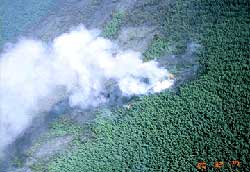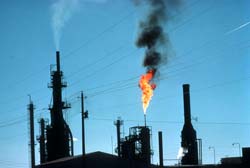Ecology, The Environment and Conservation
This complex theme deals primarily with interactions between organisms and the environmental factors that impact them, but to a greater extent between individual inanimate environmental factors.
innovations-report offers informative reports and articles on topics such as climate protection, landscape conservation, ecological systems, wildlife and nature parks and ecosystem efficiency and balance.

Are Wildland Fires Fueling the Greenhouse?
Wildland fires are taking tons of carbon out of storage and feeding it into the atmosphere as carbon dioxide, a primary greenhouse gas. Drought makes things worse, stunting tree growth and turning forests into tinderboxes. And when human activity disturbs the environment, the ability of forests to store carbon is further diminished.
These are some of the preliminary findings from computer modeling studies of the Colorado wildfires of 2002 being presented in San Francisco, December 6–10, at t

Global Pollution Hot Spots Identified
Researchers at the National Center for Atmospheric Research (NCAR) and other institutions have pinpointed the locations of high concentrations of air pollutants around the world by combining data from four satellite imaging systems. Their findings are being presented this week in San Francisco at the annual meeting of the American Geophysical Union (AGU).
The researchers used information from instruments on NASA and European Space Agency satellites to measure atmospheric levels of three typ

MIT team works toward energy-efficient Chinese homes
Inspired by a booming economy and new spending power, the people of China want the advantages that their Western counterparts have: more living space, more comfort and more amenities. Studies by MIT researchers working with colleagues from Chinese universities and development companies suggest that those dreams can be fulfilled without necessarily adopting the energy-intensive practices of the West.
Because of China’s rapid economic growth, energy consumption is also rising sharply. By

Studies dispute ultraviolet effect on amphibian population declines
For several years it has been widely believed that increased ultraviolet-B radiation because of thinning of atmospheric ozone was a major culprit in deforming amphibian offspring and dwindling populations.
Now two new studies cast serious doubt on that assumption, and the lead author of one says the belief could have had negative impacts on efforts to save amphibians.
“All of the concentration on UV might have misdirected our conservation and research priorities,” said Wendy Palen,

Fossil fuels for household use are viable option for world’s poor
Contrary to conventional wisdom, the use of fossil fuels for household cooking and heating may make more environmental sense for the estimated 2 billion rural poor in the world, according to a researcher from the University of California, Berkeley.
Because they contribute to greenhouse gas emissions, fossil fuels have been largely dismissed as a viable alternative for the one-third of the world’s population who now use coal and local biomass – including wood, crop residues and dung – for c

Combining global environmental changes yields surprising ecosystem response
Scientists have discovered that elevated atmospheric CO2 (carbon dioxide) can suppress plant growth when increases of this important greenhouse gas are combined with a broad suite of already-occurring environmental changes. According to Christopher Field, project leader and director of the new Department of Global Ecology of the Carnegie Institution of Washington, “We are now getting a much richer picture of ecosystem responses to global environmental changes, and the traditional view that elevated